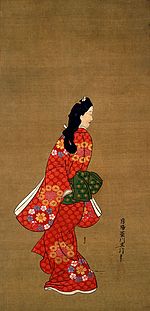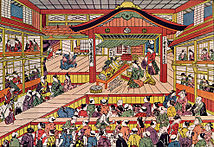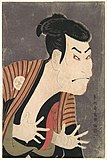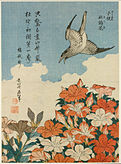Ukiyoe
|
||||||||||||
From top left:
|
||||||||||||
The ukiyo-e genre of art flourished in Japan from the 17th through 19th centuries. Its artists produced woodblock prints and paintings of such subjects as female beauties; kabuki actors and sumo wrestlers; scenes from history and folk tales; travel scenes and landscapes; flora and fauna; and erotica. The term ukiyo-e (浮世絵 IPA: [u.ki.jo.e]) translates as "picture[s] of the floating world".
Edo (modern Tokyo) became the seat of government for the military dictatorship in the early 17th century. The merchant class at the bottom of the social order benefitted most from the city's rapid economic growth. Many indulged in the entertainments of kabuki theatre, courtesans, and geisha of the pleasure districts. The term ukiyo ("floating world") came to describe this hedonistic lifestyle. Printed or painted ukiyo-e images of this environment emerged in the late 17th century and were popular with the merchant class, who had become wealthy enough to afford to decorate their homes with them.
The earliest success was in the 1670s with Moronobu's paintings and monochromatic prints of beautiful women. Colour in prints came gradually—at first added by hand for special commissions. By the 1740s, artists such as Masanobu used multiple woodblocks to print areas of colour. From the 1760s the success of Harunobu's "brocade prints" led to full-colour production becoming standard, each print made with numerous blocks. Specialists have prized the portraits of beauties and actors by masters such as Kiyonaga, Utamaro, and Sharaku that came in the late 18th century. In the 19th century followed a pair of masters best remembered for their landscapes: the bold formalist Hokusai, whose Great Wave off Kanagawa is one of the best-known works of Japanese art; and the serene, atmospheric Hiroshige, most noted for his series The Fifty-three Stations of the Tōkaidō. Following the deaths of these two masters, and against the technological and social modernization that followed the Meiji Restoration of 1868, ukiyo-e production went into steep decline.
...
Wikipedia







